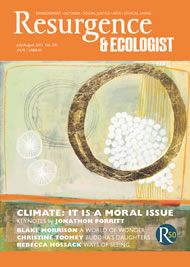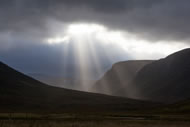In the early 1980s, my family invested in commercial forestry in Scotland, during which time I learned about deer management and grew to love these wild uplands. Over the following decade, however, I came to understand that the ecosystem of the Highlands was broken: the natural forests have almost disappeared, the soils are depleted, and many species of flora and fauna, including large predators such as lynx, wolves and bears, have been lost.
Today, largely as a result of deforestation, there remains only a tiny fraction of the original native forests, including the magnificent Caledonian pine forest. This loss of woodland cover goes hand in hand with declining biodiversity. Since 1800, 40% of species associated with woodland habitat have disappeared in Britain.
As woodlands disappear, so too does the variety of ecosystem services they provide, such as improving air, soil and water quality and reducing the risk of flooding. The National Ecosystem Assessment 2011 reported that 30% of ecosystem services are in long-term decline in Britain, while many others are in a reduced or degraded state.
This is a well-documented global issue and possibly one of the greatest challenges we face, particularly with the deepening impact of climate change. So when in 2003 I purchased Alladale, a 23,000-acre former sporting estate, it was with the intention of restoring the land to a more natural Highland ecosystem, with the wealth of biodiversity it once supported. I also established The European Nature Trust (TENT) with the same premise: to help preserve and restore the last remaining areas of wilderness and degraded habitats of Europe.
At Alladale Wilderness Reserve we have now planted 800,000 trees, restored over 500 acres of degraded peatland, reintroduced red squirrels and other species, and for the past seven years given local children the opportunity to connect with, enjoy and learn more about Nature through the Highland Wilderness Experience. Slowly but surely we are seeing biodiversity return in the form of insects, bird life, plants and animals. However, in my mind this ecosystem is incomplete without large predators.
Large predators play a vital role in restoring and regulating ecosystems and sustaining biodiversity, and are increasingly seen as important tools for conservation.
If wolves were reintroduced in Scotland, their main prey would be red deer, which, due to the absence of a non-human predator, are currently present at high densities. High deer numbers have a significant economic and ecological impact: they feed on saplings and hinder reforestation, thus limiting the numbers of birds, and they compete with livestock for grazing.
According to recent predator–prey simulations, reintroducing wolves to Alladale would likely generate conservation benefits by lowering deer numbers as well as reducing the financial burden of deer culls. Wolves could, therefore, provide a more efficient and natural means of controlling the deer population and promoting ecological restoration.
The challenge lies in making this vision to restore a native Highland ecosystem with large predators economically viable, and therefore an alternative land use to the traditional sporting estate. On my travels around the world, I came across game reserves in South Africa that are trying to do exactly that by linking Nature-based tourism with conservation. Fences are successfully used to partition predators from areas where it is incompatible for them to range freely alongside rural communities and livestock farming.
I believe that this method of creating protected areas could be used to reintroduce native predators in Scotland. Not only would a fenced reserve provide a self-sustainable model for ecological restoration, but it would also help overcome the human–wolf conflict issue that we believe would result if wolves were reintroduced initially on an unfenced basis.
With this in mind, around 10 years ago I proposed the idea of reintroducing wolves and bears to a 50,000-acre fenced wilderness reserve in the Scottish Highlands.
There is a strong argument for bringing back large predators to Scotland to aid ecological restoration. The success of the reintroduction of wolves to Yellowstone National Park, USA, serves as an example. Here wolves have led to the decline of elk, resulting not only in woodland regeneration and increasing biodiversity, but also in other, unforeseen, positive consequences, such as an increase in beavers, the stabilisation of watercourses, and a reduction in erosion.
The reserve would provide the opportunity for novel scientific insight into ecological restoration and reintroductions in the UK. This continues a track record of funding conservation research at Alladale, notably a study funded by TENT to determine the role of wild boar in forest regeneration, and another on the inclusion of food plants in practical restoration.
Bringing back large predators to a fenced reserve would boost Nature-based tourism in Scotland and provide a welcome boost to economically depressed areas in the Highlands. The popularity of wolf watching in places such as Yellowstone National Park is cited as strong evidence for this. It is estimated that in a single year the presence of wolves there led to an increase in visitor spending in the local economy of US$35.5 million. This evidence is substantiated by findings from wolf tourism in Abruzzo National Park, Italy. Bears would also provide a compelling tourist attraction.
We have an outdoor environmental education programme at Alladale called The Highland Wilderness Experience, which encourages young people to connect with, enjoy and learn more about wild Nature and the great outdoors. Reintroducing large predators to this area would enhance this experience and would provide an educationally enriching recreational resource for people of all ages.
When I first proposed the idea to the public in 2003, it was met with ridicule. Yet 10 years on we are witnessing a boom in ecological restoration and reintroduction projects across the UK, and there is growing public support for such projects. A 2007 report suggests that the Scottish public, with the exception of farmers, have a generally positive view of reintroductions, including wolves.
There is also support on a political level with initiatives such as the EU Habitats Directive of 1992, which introduced an obligation for European countries to investigate the desirability of reintroducing native species such as wolf, lynx and bear where it may contribute to species conservation. The International Union for Conservation of Nature (IUCN) identifies a number of reasons for reintroductions: to increase the likelihood of long-term survival of species, to re-establish keystone species, to promote biodiversity, and to provide economic benefits.
It is clear, however, that a landscape-scale fenced wilderness reserve in Scotland would raise numerous ecological, economic, social, legal and ethical questions that would need to be addressed. Ultimately, making it a reality would depend on consensus on a local and a political level.
The reserve would have to be approved by Scottish Natural Heritage, the government body responsible for wildlife and habitats in Scotland, and be widely welcomed by the whole spectrum of land users and interests in Scotland. This will not happen until we are able to build a strong case for the proposal, and we are launching a socio-economic impact study to determine whether it makes economic sense.
Research published in 2012 concluded that the reintroduction of large predators in a large, fenced wilderness reserve in the Scottish Highlands, with its potential benefits to biodiversity conservation and economic development, merits serious consideration. This view was endorsed in March 2015 by the acclaimed naturalist Sir David Attenborough. Clearly, many other studies will need to follow, but once a case is made it will be up to the multitude of stakeholders to decide whether the vision I am proposing here will become a reality.
Who knows if it will take shape in Scotland? My hope is that we will find a way of restoring a part of the Highlands back to its former glory, with all the multitude of benefits this would entail.
What is clear is that our generation and generations to come face some very real environmental challenges, and finding solutions will require a shift in perspective and some good ideas – possibly even radical ones.
For more information about the Alladale Wilderness Reserve visit: www.alladale.com/about-alladale.html
Paul Lister is an English eco-philanthropist and advocate for the conservation of the Scottish Highlands.








